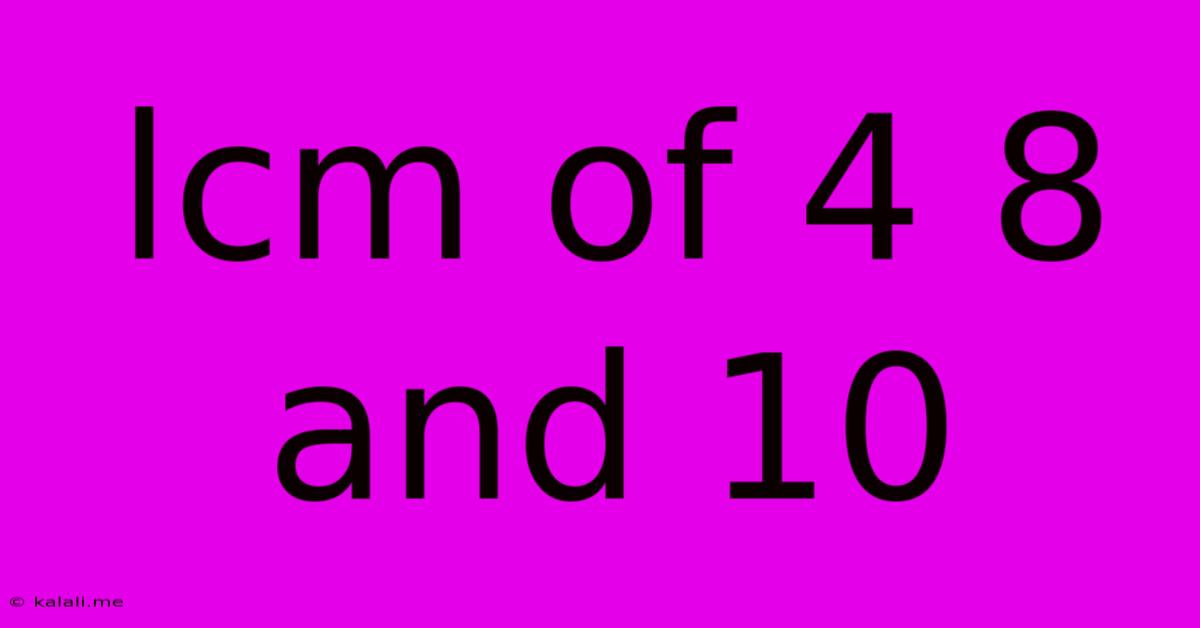Lcm Of 4 8 And 10
Kalali
Jun 14, 2025 · 2 min read

Table of Contents
Finding the Least Common Multiple (LCM) of 4, 8, and 10
This article will guide you through the process of calculating the Least Common Multiple (LCM) of 4, 8, and 10. Understanding LCM is crucial in various mathematical applications, from simplifying fractions to solving problems involving cycles and timing. We'll explore different methods to find the LCM, making this concept accessible to everyone.
What is the Least Common Multiple (LCM)?
The Least Common Multiple (LCM) is the smallest positive integer that is a multiple of two or more numbers. In simpler terms, it's the smallest number that all the given numbers can divide into evenly. For instance, the LCM of 2 and 3 is 6, because 6 is the smallest number divisible by both 2 and 3.
Methods for Finding the LCM of 4, 8, and 10
There are several ways to determine the LCM of 4, 8, and 10. Let's explore two common approaches:
1. Listing Multiples Method
This method involves listing the multiples of each number until you find the smallest multiple common to all.
- Multiples of 4: 4, 8, 12, 16, 20, 24, 28, 32, 36, 40, ...
- Multiples of 8: 8, 16, 24, 32, 40, ...
- Multiples of 10: 10, 20, 30, 40, ...
By comparing the lists, we can see that the smallest multiple common to 4, 8, and 10 is 40. Therefore, the LCM(4, 8, 10) = 40. This method is straightforward for smaller numbers but can become cumbersome with larger numbers.
2. Prime Factorization Method
This method is more efficient for larger numbers. It involves finding the prime factorization of each number and then constructing the LCM using the highest powers of each prime factor.
- Prime factorization of 4: 2²
- Prime factorization of 8: 2³
- Prime factorization of 10: 2 x 5
To find the LCM, we take the highest power of each prime factor present in the factorizations:
- The highest power of 2 is 2³ = 8
- The highest power of 5 is 5¹ = 5
Now, multiply these highest powers together: 8 x 5 = 40
Therefore, the LCM(4, 8, 10) = 40 using the prime factorization method. This method is generally more efficient, especially when dealing with larger numbers or a greater number of numbers.
Applications of LCM
Understanding LCM has practical applications in various fields:
- Fraction Addition and Subtraction: Finding a common denominator when adding or subtracting fractions.
- Scheduling Problems: Determining when events will occur simultaneously (e.g., buses arriving at a stop).
- Measurement Conversions: Converting between different units of measurement.
- Cyclic Processes: Analyzing repeating patterns or cycles.
Conclusion
Finding the Least Common Multiple is a fundamental concept in mathematics with broad applications. Both the listing multiples and prime factorization methods provide effective ways to calculate the LCM, with the prime factorization method being generally more efficient for larger numbers. Understanding these methods empowers you to solve a wider range of mathematical problems. Remember, the LCM of 4, 8, and 10 is definitively 40.
Latest Posts
Latest Posts
-
What Is The Integral Of Sin 2x
Jun 14, 2025
-
What Is Conjugate Base Of H2po4
Jun 14, 2025
-
College Of San Mateo Acceptance Rate
Jun 14, 2025
-
Economics Is Best Defined As The Study Of
Jun 14, 2025
-
Which Of The Following Is Not An Example Of Symbiosis
Jun 14, 2025
Related Post
Thank you for visiting our website which covers about Lcm Of 4 8 And 10 . We hope the information provided has been useful to you. Feel free to contact us if you have any questions or need further assistance. See you next time and don't miss to bookmark.